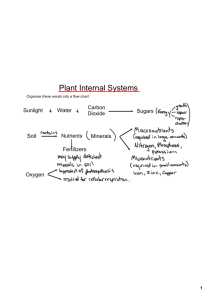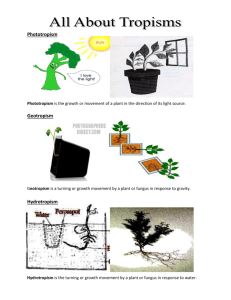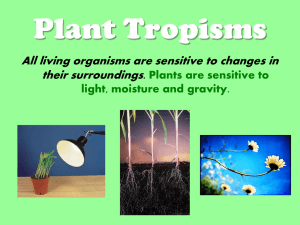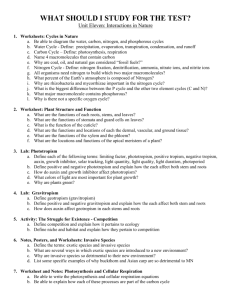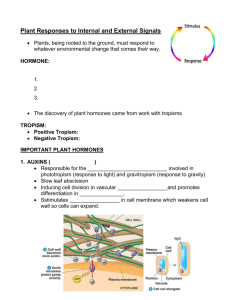Unique Tropisms In Plants
advertisement
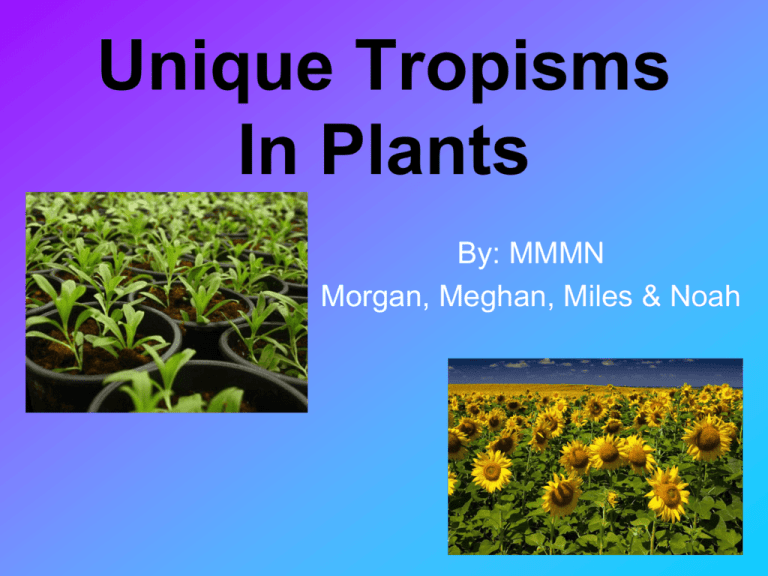
Unique Tropisms In Plants By: MMMN Morgan, Meghan, Miles & Noah What is a tropism? Definition: A tropism is the turning or bending movement of an organism toward or away from an external stimulus such as light, heat, or gravity. • Tropisms are directional movement responses that occur in response to a directional stimulus. • The word “tropism” come from the Greek word “trope”, which means “a turning” • Tropisms can be positive or negative. • One of the most commonly observed tropic responses in plants is phototropism. Positive and Negative Tropism Plants are able to alter their growth so they can grow into more favorable conditions. To do this requires a plant’s ability to detect where the conditions are better, and then alter their growth so they can "move" in the appropriate direction. There are many types of tropisms, but only 2 ways that tropism can occur; positively and negatively. Positive Tropism In positive tropism, a plant will bend and grow toward a stimulus. Ex. Roots of plants exhibit positive gravitropism when growing, because they grow down, toward the direction of gravity. Negative Tropism In negative tropism, a plant will bend and grow away from a stimulus. Ex. Shoots of plants show negative gravitropism during growth, because they grow upward, against the force of gravity. Types of Tropisms There are many types of tropisms, or ways that plants respond to an external stimulus. Some of these types of tropisms are: Phototropism- movement or growth in response to light Gravitropism (or Geotropism)-movement or growth in response to gravity Thermotropism- movement or growth in response to heat/temperature Hydrotropism- movement or growth in response to water Thigmotropism- movement or growth in response to touch or contact Chemotropism- movement or growth in response to chemicals Heliotropism- movement or growth in response to sunlight Host tropism or Cell tropism is a tropism process that determines which cells can become infected by a certain pathogen Phototropism Phototropism is directional growth in response to a light stimulus. • Think: “Photo” means “light” An example of this is “Photosynthesis”, which means “Creation of a new chemical (synthesis) with light” Phototropism can be positive or negative. • Positive phototropism is growth toward a light source. • Negative phototropism is growth away from a light source. One of the most known plant examples of phototropism is the sunflower. Phototropism II • Most plant shoots exhibit positive phototropism, and roots usually exhibit negative phototropism but gravitropism usually plays a larger part in their behavior and growth. • Some vine shoot tips show negative phototropism. This allows them to grow towards dark, solid objects, like tree trunks, and climb them. • The reason that phototropism is possible is because of auxins. Auxins are hormones in plants that cause plants and leaves to show a positive response to sunlight. • When light shines on one side of the plant, the auxin moves to the shaded side and causes the cells to become longer. This uneven growth makes it possible for the plant to bend to the sunlight. • Auxins also control the production of other hormones in plants. • In sunflowers, a hormone inside the plant is very important for phototropism. This hormone is called Indole acetic acid. It regulates the entire process. The most important job of IAA is to stimulate cell growth and enlargement wherever it is located. Gravitropism Gravitropism is the turning or growth movement of a plant or fungus in response to gravity. Also known as Geotropism Charles Darwin was one of the first scientists to document that roots show a positive form of gravitropism and stems show a negative form of gravitropism. Interesting Fact: Plants in a pot can continue to show gravitropism, even when they are turned on their side! Based on the pull of gravity, the roots and stem can orient their growth to the correct position. (Stems move to face upward and roots orient themselves to grow downward.) You can see this in the picture above and in the video. Auxins also play a part in gravitropism, not just phototropism. During gravitropism, auxins carry signals from the root cap to the zone of elongation. This is an important part of the process of growth response. Thermotropism Thermotropism is the movement of a plant or part of a plant in response to changes in temperature. An example of a thermotropic plant is the rhododendron. It is classified as having thermotropic or temperature-sensitive leaf movements. Charles Darwin fist categorized leaf movements in the year 1880, in his book The Power of Movement in Plants. Darwin said that many plant parts, particularly leaves, move in response to a number of environmental and physiological factors. The most important environmental factors are light intensity (phototropic), light direction (heliotropic), water content (hydrotropic), and temperature (thermotropic). The Rhododendron’s thermotropic leaf movements are unusual because these movements are in response to cold temperatures and the leaves become pendent instead of vertical. Hydrotropism The prefix “Hydro” means “Water”, so, of course, Hydrotropism is a plant growth response where the direction of growth is determined by a stimulus of ascent/descent in water concentration. o A typical example of hydrotropism is when plant roots grow in humid air. Hydrotropism causes the roots to bend toward a place in the air with a higher humidity level. o The hydrotropism process is starts with the root cap sensing water and sending a signal to the part of the root which is being made longer. o Hydrotropism is hard to observe in roots growing underground, because these roots aren’t very observable. Gravitropism in roots is also usually more of an influence than hydrotropism. o For these two reasons, most of the research pertaining to root hydrotropism has been conducted on roots growing in humid air, instead of in soil. Thigmotropism Thigmotropism is a movement or response in which an organism moves or grows as a response to a stimulus of touch or contact. The prefix “thigmo” comes from the Greek for "touch". Think: “Thigmotropism” and “Thumb” both start with Th- and you touch things with your thumb. Use this tool to help you remember what thigmotropism is. • Thigmotropism occurs most often when plants grow around a surface, like a wall, pot, or trellis. Climbing plants, such as vines, develop tendrils that coil around these supporting objects. • Get this!: Auxin is involved in thigmotropism, too! Touched cells produce auxin and transport it to untouched cells. Some untouched cells will then become longer, faster, then cell growth bends around the object. • The plant Mimosa pudica is widely known for its rapid plant movement. Its leaves close up and droop when touched, but this is not a form of tropism. It is a nastic movement, which is similar to a tropism, but not the same thing. Thank you for watching! This slide will self-destruct in…

